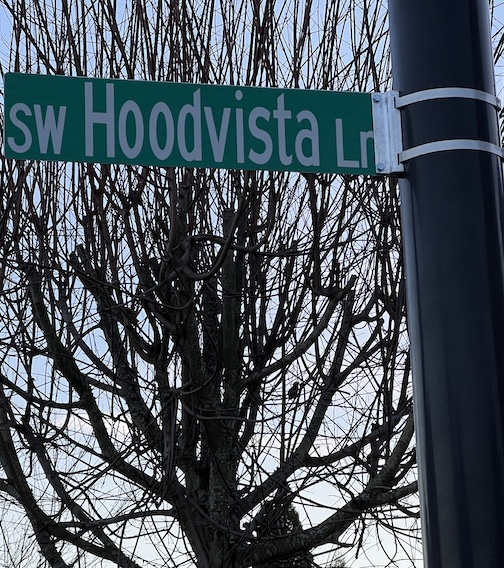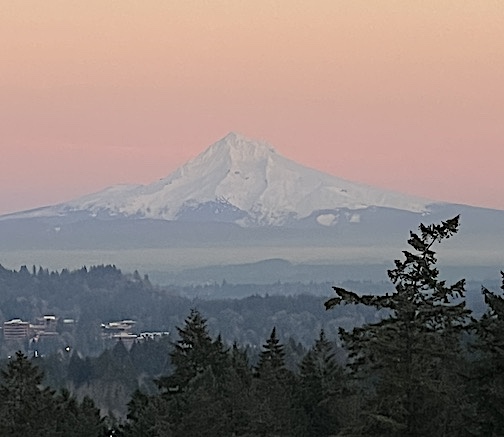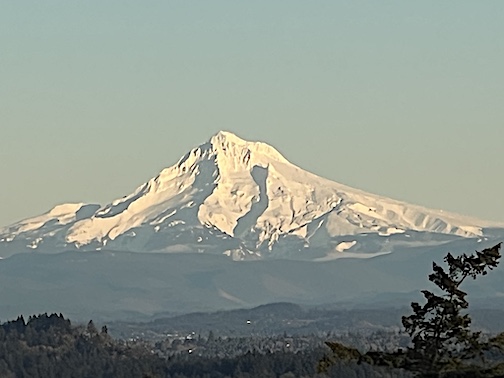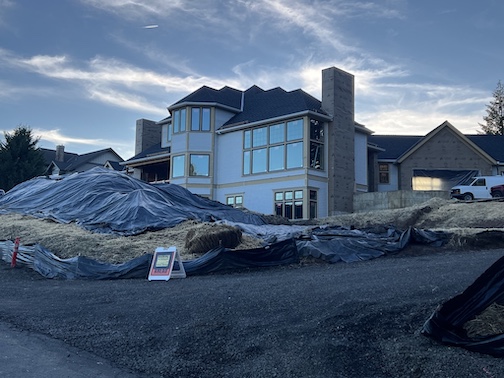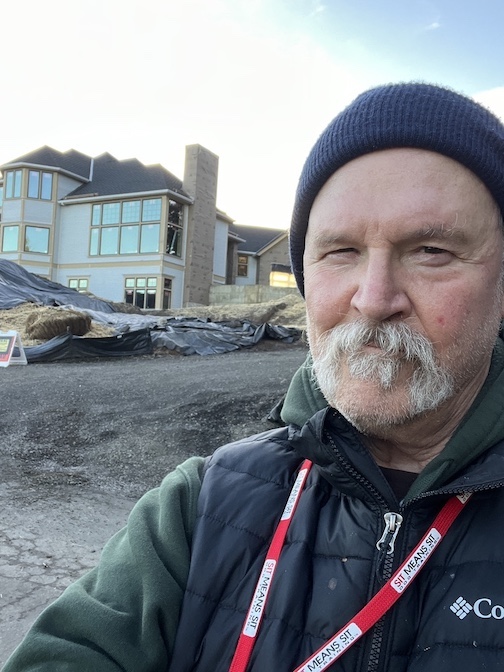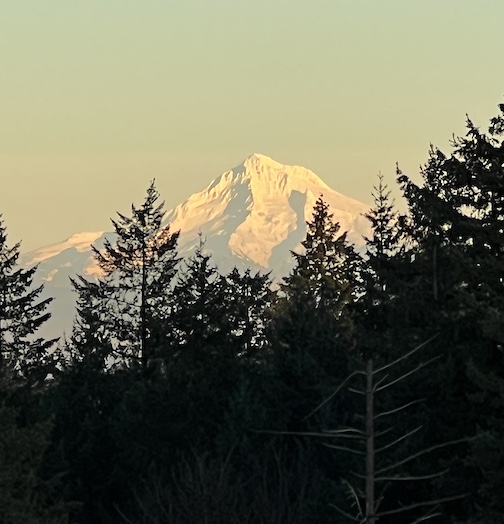The Mount Hood view is so good from the neighborhood that streets are named after it.
That’s what you get in a town near a mountain.
You could say a town near a mountain range since there’s also a view of Mt. St. Helens and Mt. Adams to the north, Mt. Jefferson to the south on a clear day.
But the Cascades show one mountain at a time, not an uplifted region like the Rocky Mountains that looks like an outsized gravel pit.
How’s the view from Hoodvista Lane? Beautiful:
Portland people have seen Mt. Hood so often it’s taken for granted. New people get more excited.
“The mountain is out,” is the cry on a clear day.
What makes it so special?
On a hot day you can look at a snow covered mountain and cool off; on a cold day you can warm up by looking at the mountain and feel glad you’re not on it.
I’ve been looking at it from many angles over the years.
You can walk to a view anyplace in town. From NW to NE, from SE, to SW, there it is.
I had the idea of making it to the summit and started training.
Whether you’re a mountain climber or not, getting ready for the ordeal is a good way to shape up.
To stick with it you need to accept the possibilities:
You could freeze to death in a white-out.
Every year, on the second Wednesday in May, the students and faculty of Oregon Episcopal School, as well as staff members, parents, alumni, and friends gather around the Belltower for Mount Hood Climb Observance Day.
This tradition began as a way to remember the Mount Hood Climb tragedy that occurred in May of 1986, taking the lives of seven students, the school chaplain, and a dean.
You could be drug into a crevasse by a climber’s rope you’re attached to and die from everyone else landing on you, if not from the fall.
A group of four men were roped together and making their way down the mountain when one of them lost his footing and fell, pulling the other three down despite their efforts to stop themselves.
The four hit two other men who had been making their way up and were also roped together, and they were dragged along as the group tumbled down the mountainside, hitting three more roped-up people on the way.
The first event happened the day after my wedding in Sandy with the first night of our honeymoon in Timberline Lodge, which we’ve visited since.
The second event included a guy from work, an adventure guy.
We went to his memorial.
Mount Hood carries memories for all who’ve been close to it.
I’m glad to think I would have made it up and down. That would have been a good memory.
Instead, I chose another landmark to hang on my endurance list: The Mormon church in Lake Oswego.
My wife dropped me off and I walked back five miles up Bull Mountain and called it good.
Changing Mount Hood Views
I walk my dog to a patch of forest with trails called Bull Mountain Park, about ten minutes from my front yard.
The usual packed in houses of a normal neighborhood thins out to a single lane access road with two house across from a vacant field of maybe two down-sloping acres.
The first house is a suburban castle with peaked roofs and windows facing the image on top.
It’s an unparalleled view, second only to my pal’s backyard. (Hey Jerry)
Next to it on a huge lot, and the last house on the access road before the woods, is a seventies-style big house with a swimming pool and tennis court.
One day I noticed a crane rig with a big scoop front ripping the 70’s house to shreds.
It looked like old school fun with no thought to reclaim, recycle , or reuse anything.
They tore it down to the foundation, then broke the foundation like they did the tennis court and swimming pool, and dug a deep hole.
I’ve been a fan of digging a deep hole from walking around downtown Portland.
If you’ve ever parked in a subterranean lot, that’s what the holes are for.
What’s the big hole in suburban dirt? I don’t know, but if were me, I’d dig it deeper.
During my most recent walk a local historian gave his interpretation. He had a lot to say.
The old house was owned by a wealthy family, which wasn’t news with a tennis court and swimming pool.
The original owners passed on and their kids made changes in the property, big changes, beginning with a bare slate where the house and extras used to be.
It went from dig, dig more, to pouring cement and building walls, roof, and windows.
This is the current state:
This is the front facing the Mount Hood view.
The empty two acres in front will preserve the view.
I think it’s pretty great to have this addition on the walk.
My estimate of size runs about 12,000 sq. ft. since it goes all the way to the left and back.
The history guy said it has a couple of elevators too.
I visited the house of the White Stag founder in Portland’s west hills and he had an elevator.
Who wouldn’t want an elevator in their house?
Local History Of Big Houses Without The View
My old boss had a 10,000 sq. ft. mansion in the West Hills.
In my provincial view, anything that size is a mansion.
When he had a party the house was the star.
This looks like an Allstar house.
With that said, these folks could have built anywhere.
Since economics doesn’t play a role, they could have built in Lake Oswego just across the freeway for a prestigious address.
I’ve been in the home on the Lake Oswego point and thought, ‘I could be comfortable here.’
But they wanted the Hood view over a wide expanse of vacant land.
I respect that, since I’ve also got a Hood view.
From my small bathroom window.
After the trees have lost their leaves.
There’s something about that mountain that I like to keep an eye on.
It’s a volcano, and around here we’re all about the volcano, just not this one.
Knowing it can change in an instant makes it more special.
Mt. St. Helens was once called America’s Mt. Fuji.
Then it blew.
If, when, Mt. Hood blows, we’ll have a better view than Harry Truman did on Spirit Lake Lodge.
You’ll find me at the bathroom window.
